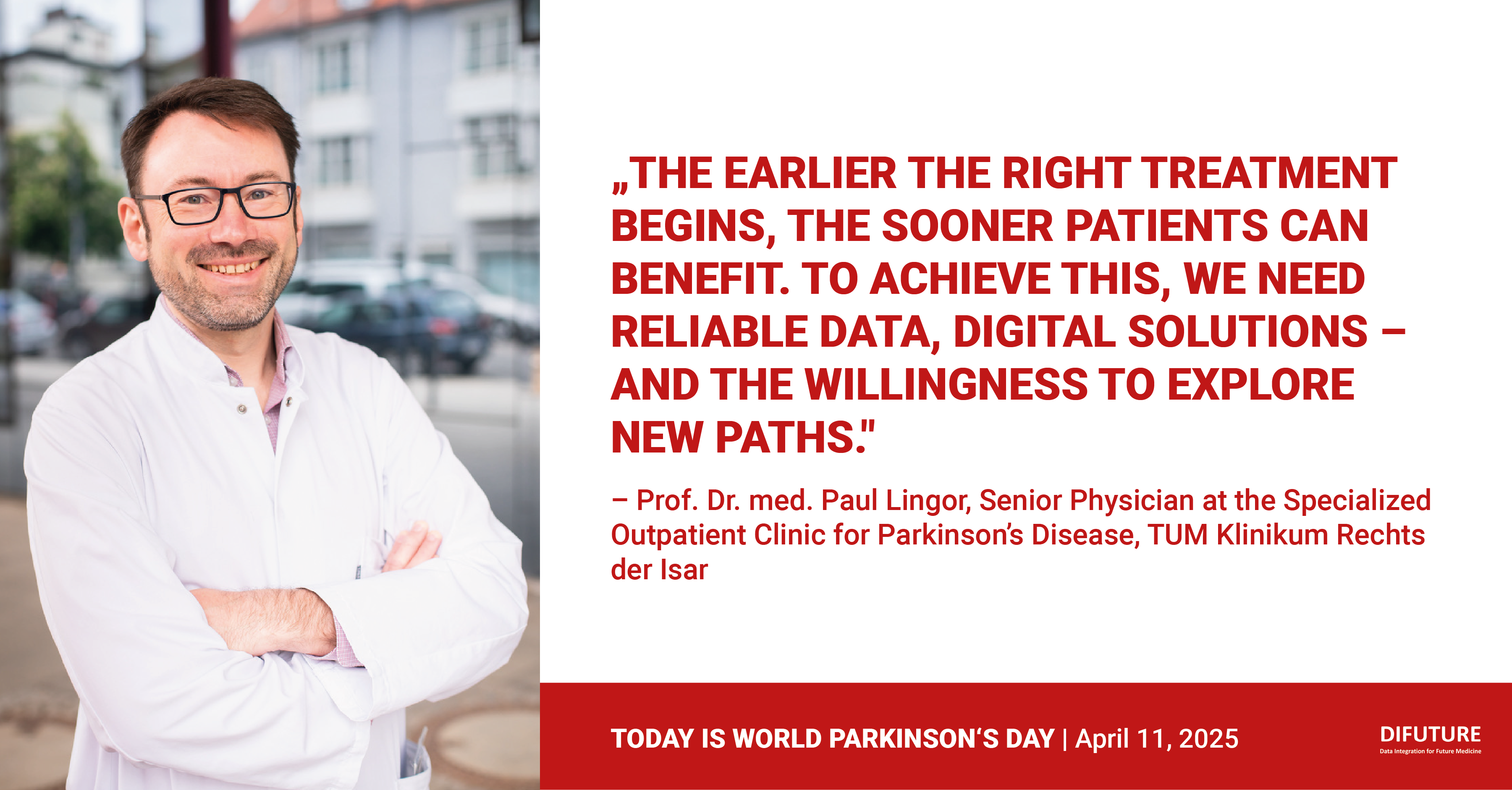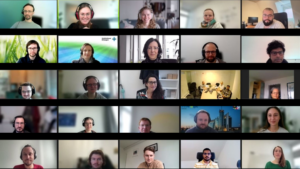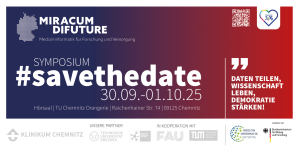For many people living with advanced Parkinson’s disease, this is part of everyday life. While oral medications often work well in the early stages, their effectiveness tends to diminish over time. Non-oral advanced therapies (NOAT) such as deep brain stimulation, infusion pumps, or focused ultrasound can help – but they are often considered too late.
Why? One key reason is the lack of reliable data indicating when and for whom these more invasive treatments are the right choice. As part of the Medical Informatics Initiative (MII), we at DIFUTURE are working together with Prof. Dr. Paul Lingor to establish a nationwide Parkinson’s registry: RAP-PD. The goal is to generate more evidence on NOAT through structured data and standardized documentation.
On World Parkinson’s Day, we spoke with Prof. Dr. Paul Lingor, a neurologist at TUM’s Klinikum rechts der Isar, about why education, collaboration, and structured data are essential levers for better care – and how RAP-PD aims to help close existing gaps in treatment.
What is Parkinson’s disease?
Parkinson’s disease is a chronic brain disorder in which specific nerve cells—called dopaminergic neurons—die off. Although the disease is not yet curable, there are already many effective therapies that can make everyday life easier and improve quality of life.
What are the first signs of the disease?
Typical early signs include slowed movements and sometimes a resting tremor in one hand. However, non-specific symptoms such as a soft voice, depression, loss of sense of smell, or sleep disturbances can also serve as early indicators. The key is: the earlier the right therapy begins, the more patients can benefit. For that, we need reliable data, digital solutions—and the willingness to explore new approaches.
What challenges do you face in treating advanced Parkinson’s disease in everyday clinical practice?
In the early years, various medications—often taken in tablet form—work quite well, especially in improving mobility. Physiotherapy is also very important during this stage. However, as the disease progresses, the effectiveness of medication becomes less reliable. Patients may experience significant fluctuations in mobility throughout the day, even when medication is taken correctly. Other symptoms may also appear, such as problems with sleep, swallowing, or memory. These so-called “non-motor symptoms” are often particularly difficult to treat.
What role do NOAT play in your clinical practice?
These therapies are usually used in later stages of the disease and go beyond tablet-based treatment. They involve more complex technical procedures, such as surgery or medication pumps. We know these therapies can be very effective, but their complexity often discourages patients. That’s why it’s so important to inform patients early and involve them in the decision-making process.
When do you think is the right time for a NOAT?
That’s precisely the issue—there isn’t a single, clearly defined right moment. A general rule of thumb is when someone needs to take tablets more than four times a day—at that point, one should start considering continuous treatments like a pump or deep brain stimulation. Many patients hesitate—out of fear of surgical procedures or technical devices. So it’s all the more important to speak openly and early about these options.
What information is currently missing when planning or adjusting therapy?
In many cases, several therapies could be suitable for a given patient. Here, prospective data would help us make better decisions and better estimate the ideal timing for switching to such treatments. Even NOAT options have limits in terms of their long-term effectiveness or side effects. More robust data from prospective studies would be very helpful in making informed decisions about therapy changes or combinations.
How can a registry like RAP-PD help improve care for Parkinson’s patients?
A registry collects data from patients currently undergoing treatment. It reflects real-world care much more accurately than a clinical trial ever could. This kind of data helps us better understand reality—and plan more targeted clinical studies in the future.
What role do you think medical informatics will play in future treatment decisions?
The value of medical informatics cannot be overstated. Only through high-quality data collection and analysis can we make well-founded statements. Medical informatics creates the necessary structures—and helps translate complex datasets into clear, clinically meaningful answers.
How important is collaboration between different centers when managing complex Parkinson’s cases?
Numerous centers across Germany are expected to participate in the registry. Many of them are also deeply involved in research on advanced stages of Parkinson’s disease. Therefore, data from the registry can be used for joint research projects. Regular meetings with all project partners will allow for the exchange of ideas and problem-solving within the RAP-PD initiative.
What are your personal hopes for participating in the RAP-PD registry?
Beyond the scientific benefits, I particularly look forward to exchanging ideas with many colleagues and discussing collaborative research projects. The registry can serve as a foundation for numerous future studies in the field of advanced Parkinson’s disease.
If you could make one wish to policymakers or the research community—what would need to change to improve care for Parkinson’s patients?
Networking, digitization, and funding for research into disease-modifying therapies are, in my view, the most important areas. Networks that bring together everyone involved in Parkinson’s care can create real added value. We need digital tools for data sharing, and the RAP-PD registry is a good example of that. At the same time, developing disease-modifying therapies that address the root cause of the disease is critical. Much greater investment in research funding is needed to advance the development of new medications. We ourselves are involved in clinical trials focused on the development of such compounds.
What gives you hope when dealing with this disease—for your patients, and also for yourself as a physician?
Compared to many other neurodegenerative diseases, Parkinson’s is more treatable today. Our increasing understanding of the disease’s causes—and the encouraging advances made recently in other neurodegenerative conditions—give me hope that we will be able to do much more for our patients in the coming years.
We sincerely thank Prof. Dr. Paul Lingor for the interview – and all those who work every day to improve the quality of life and create a better future for people living with Parkinson’s disease.




